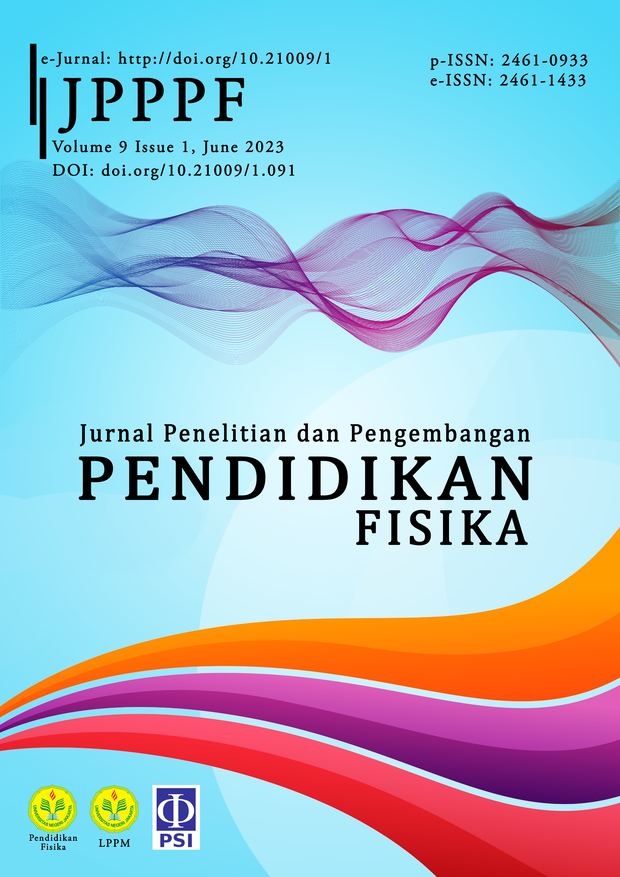Development of Supplementary Basic Physics Practicum Based on Problem-Solving Method Assisted with Augmented Reality (AR) Technology
DOI:
https://doi.org/10.21009/1.09105Keywords:
supplementary practicum, problem-solving, augmented reality, coastal areaAbstract
Physics practicum is an important activity in basic physics courses that involve contextual physics concepts, such as cases in coastal areas which can demand students’ problem-solving skills. Covid-19 has caused basic physics practicum activities to become difficult to carry out in a laboratory scale, thus alternative solution is necessary to perform practical activities in the Covid-19 situation, namely by utilizing Augmented Reality (AR) technology. AR can help visualize physics concepts and practicum activity procedures relevant to practicum activities. This study aimed to develop an AR-assisted practicum guidebook product oriented toward a problem-solving method by presenting several cases of natural potential in local coastal areas. This study used an R&D method with a 4D model. However, this study was limited to the development stage. Data were collected with validation sheets and student response questionnaire sheets. These data were then analyzed with descriptive qualitative data analysis technique. Based on the data analysis results, many students had difficulties in carrying out physics practicum activities during the Covid-19 pandemic. This occurred due to the unaccessible practicum video procedures in the guidebook during the offline condition. Furthermore, the practicum procedure guidebook was only in narrative text, unable to stimulate high-level thinking skills by presenting coastal area cases. Students must be introduced deeper to the potential of coastal areas and their relation to physics concepts.
References
Amir, A 2016, ‘The Use of Image Media in Mathematics Learning’, Jurnal Eksakta, vol. 2, no. 1, pp. 34-40.
Arifah, I, Maftukhin, A & Fatmaryanti, SD 2014, ‘Development of a Guided Inquiry-Based Practicum Manual for Optimizing Hands On Semester II Students of the Physics Education Study Program’, Radiasi [Preprint], University of Muhammadiyah Purworejo Academic Year 2013 / 2014, Available at: https://doi.org/10.1177/1477370812440064.
Arifin, MH, Affandi, I & Maryani, E 2022, ‘IPS Learning Through Utilization of Coastal Area Potential’, Jurnal Pendidikan Tambusai, vol. 6, no. 2, pp. 11357-11361.
Chang, HY 2022, ‘Ten years of augmented reality in education: A meta-analysis of (quasi-) experimental studies to investigate the impact’, Computers and Education, vol. 191, p. 104641, Available at: https://doi.org/10.1016/j.compedu.2022.104641.
Darmaji, Dwi Agus Kurniawan, Astalini, SCS 2019, ‘Perceptions of Biology and Chemistry Education Students on the Use of Mobile Learning-Based Basic Physics Practicum Handbooks’, Edusains [Preprint], vol. 11, no. 2, pp. 213-220.
Fitriyah, F, Sumpono, I & Subali, B 2018, ‘Design of a light refraction practicum tool to help improve students’ problem solving abilities’, Jurnal Inovasi Pendidikan IPA, vol. 4, no. 2, pp. 169-180.
Hayati, S, Budi, AS & Handoko, E 2015, ‘Development of Physics Flipbook Learning Media to Improve Student Learning Outcomes’, Prosiding Seminar Nasional Fisika (E-Journal), vo. 4, pp. 49-54.
Ilmawan, M 2016, ‘Utilization of Augmented Reality as Learning Media’, Journal of Technology and Vocational Education, vol. 13, no. 2, pp. 728-732, Available at: https://doi.org/10.1109/SIBIRCON.2010.5555154.
Johan, H 2018, ‘Impact of Learning Earth Litosphere using Interactive Conceptual Instruction on Logic Thinking, Conceptual Understanding, and Spiritual Aspect Embedding’, Jurnal Pendidikan Fisika Indonesia, vol. 14, no. 1, pp. 7-17, Available at: https://doi.org/10.15294/jpfi.v14i1.8259.
Koes, HS 2003, ‘Physics Learning Strategy’, Universitas Negeri Malang.
Marcel, J 2023, ‘Augmented reality android based : Education of modern and traditional instruments’, Procedia Computer Science, vol. 216, pp. 266-273, https://doi.org/10.1016/j.procs.2022.12.136.
Matsun, M, Ramadhani, D & Lestari, I 2018, ‘Android-Based Design of Electric Magnetic Learning Media in the Physics Education Study Program Of Ikip Pgri Pontianak’, Jurnal Pendidikan Matematika dan IPA, vol. 9, no. 1, pp. 99-107.
Novita, E 2020, ‘Development of a Basic Science Process Skills-Based Practicum Handbook for Grade IV Elementary Schools’, Journal Evaluation in Education (JEE), vol. 1, no. 1, pp. 34-41, Available at: https://doi.org/10.37251/jee.v1i1.38.
Noviyanto, TSH, Juanengsih, N & Rosyidatun, ES 2015, ‘Use of Human Respiratory System Animation Video Media to Improve Biology Learning Outcomes’, Edusains, vol. 7, no. 1, pp. 57-63, Available at: https://doi.org/10.15408/es.v7i1.1215.
Pai, YS 2016, ‘Virtual Planning, Control, and Machining for a Modular-Based Automated Factory Operation in an Augmented Reality Environment’, Scientific Reports, vol. 6, no. 1, pp. 1-19, Available at: https://doi.org/10.1038/srep27380.
Prastowo, A 2011, ‘Creative Guide to Creating Innovative Teaching Materials: Creating Interesting and Fun Methods’, Diva Press.
Qurrotaini, L, Sari, TW & Sundi, VH 2020, ‘The Effectiveness of Using Powtoon-Based Video Media in Online Learning’, Proceedings of the UMJ LPPM National Research Seminar, E-ISSN, vol. 27, no. 7, Available at: https://jurnal.umj.ac.id/index.php/semnaslit/article/view/7869.
Rustaman, N 2003, ‘Teaching Media’, Bandung: Sinar Baru.
Sudarman & Saparuddin, M 2018, ‘Development of an Ebook Practicum Guide as a Supplement to Support Blended Learning’, p. 6.
Suryaningsih, Y 2017, ‘Practicum-Based Learning as a Means for Students to Practice Applicing Science Process Skills in Biological Materials, Configuration’, Journal of Chemistry and Applied Education, vol. 2, no. 2, Available at: https://doi.org/10.24014/konfigurasi.v1i2.4537.
Sylvia, F, Ramdhan, B & Windyariani, S 2020, ‘The Effectiveness of Augmented Reality Against Students’ Higher Order Thinking Skills in Biology Learning’, Biodik, vol. 7, no. 2, pp. 131-142, Available at: https://doi.org/10.22437/bio.v7i2.13034.
Thees, M 2020, ‘Effects of augmented reality on learning and cognitive load in university physics laboratory courses’, Computers in Human Behavior, vol. 108, p. 106316, Available at: https://doi.org/10.1016/j.chb.2020.106316.
Wang, YJ 2017, ‘Augmented reality with image registration, vision correction and sunlight readability via liquid crystal devices’, Scientific Reports, vol. 7, no. 1, pp. 1-12, Available at: https://doi.org/10.1038/s41598-017-00492-2.
Widiasih, Johan, H & Pandiangan, P 2021, ‘Development of a Physics Practicum Model Using Augmented Reality Technology: A Preliminary Analysis’, Proceedings of the International Conference on Educational Sciences and Teacher Profession (ICETeP 2020), vol. 532, pp. 214-217, Available at: https://doi.org/10.2991/assehr.k.210227.038.
Zidniyati 2018, ‘Strengthening Character Education in Elementary Schools in the Industrial Revolution Era 4.0’, Tarbiyah, vol. 3, no. 1, pp. 1-17, Available at: https://doi.org/10.1145/3132847.3132886.











